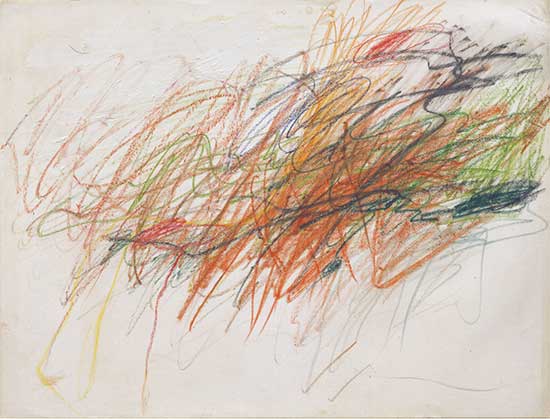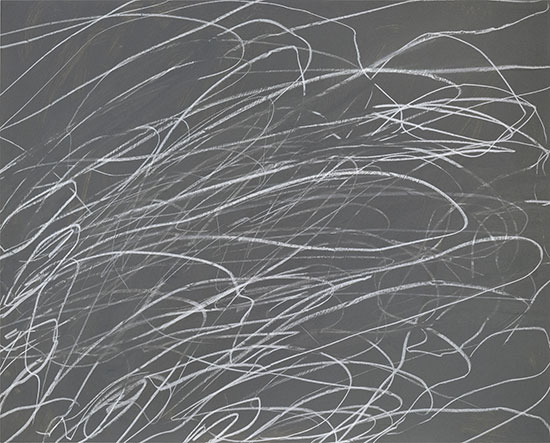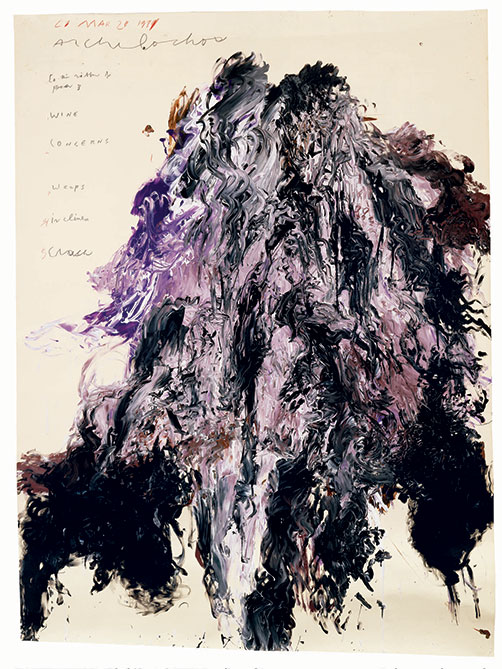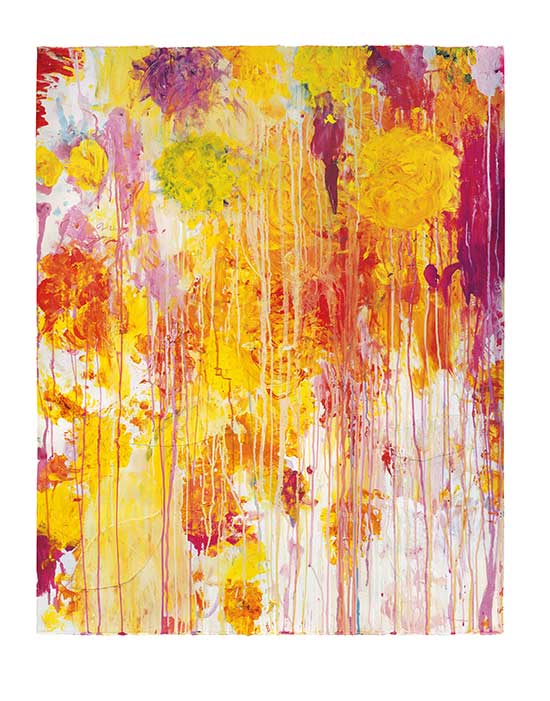“In Beauty it is finished: Drawings 1951-2008,” the Cy Twombly exhibition currently on view at Gagosian on West 21st Street, is an appropriately expansive tribute to one of the great, and most abstruse, artists of post-war American abstraction.
A career-spanning installation, the show is presented in celebration of the 90th anniversary of the birth of Cy Twombly (1928-2011), and of the completion of the eight-volume Cy Twombly: Catalogue Raisonné of Drawings. To this end, the vastness of Gagosian’s 21st Street gallery is a fitting space in which to encounter the work of an artist deeply influenced by the storytelling richness of ancient epic and myth, and to be swept along on Twombly’s own odyssey of pictorial exploration.
Structured chronologically, the exhibition consists of works on paper from various stages of the artist’s career, beginning with summary pencil scrawls of the early 1950s, when Twombly was a student at Black Mountain College in North Carolina, and ending with three works from 2008 filled almost to bursting with blood-red spirals of acrylic paint.
The earliest drawings, composed of graphite scribbles, read less like finished works intended for public view than the workings-out of an irrepressible young artist obsessed by mark making. By opening with a display cabinet containing a number of summary sketches from an album Twombly created in 1951, this focus on working practice is emphasized curatorially; a major component of the exhibition’s strength is the insight it offers into Twombly’s artistic process.
.

CY TWOMBLY, "Untitled," 1954. Gouache, wax crayon, and colored pencil on paper, 19 1/8 × 25 1/4 inches (48.5 × 64 cm). Collection Cy Twombly Foundation. © Cy Twombly Foundation. Courtesy Gagosian.
.
After the frantic, germinal drawings of the 1950s, certain themes emerge that characterize Twombly’s oeuvre. He moved to Rome in 1957 and the culture and landscape of Italy—as well as his formidable knowledge of literature and his fascination with the physical marks of writing—are influential forces. Untitled, 1969, for instance, belongs to a group of paintings and drawings described as Twombly’s “blackboard” compositions, which he began in the mid-1960s.
.

CY TWOMBLY, "Untitled," 1969. Oil and wax crayon on paper, 27 5/8 × 34 1/4 inches (70 × 87 cm). Collection Cy Twombly Foundation. © Cy Twombly Foundation. Courtesy Gagosian.
.
With energetic white markings on a grey ground, the drawing celebrates the expressive possibilities of line both as autonomous object and as sign, while its undulating forms anticipate the imagery of nature that pervades his later work. Similarly phallic shapes inform Twombly’s earlier drawings, such as Dawn (See Naples + Die), 1960.
Twombly often remarked on his profound love of landscape, and the murky, sensual qualities of humus-rich soil and turbulent seas are present in works such as the four-part Paesaggio, 1980, composed of varying degrees of dark, earthy tones. These evocations are also in Untitled (Gaeta), 1989, in which the abstract mass of purple, black, and white acrylic and tempera brushstrokes calls to mind an explosion of wine-ready grapes during harvest.
.

CY TWOMBLY, "Untitled (Gaeta)," 1989. Acrylic and tempera on paper mounted on wooden panel, 80 × 58 5/8 inches (203.2 × 148.9 cm). Private Collection. © Cy Twombly Foundation. Courtesy Gagosian.
.
Gaeta, a coastal town in central Italy where Twombly maintained a home and a studio overlooking the sea, lends its name to a number of the artist’s works that tend to evoke the natural world. In the case of Untitled (Gaeta), the brooding colors and gestural brush marks give painterly expression to hedonic Mediterranean climes. But, by including a series of enigmatic, variously discernable words, including “WINE,” “CONCERNS,” and “weeps,” Twombly moves beyond the pure abstraction of the Abstract Expressionists to embrace the communicative possibilities of poetic allusion.
A trio of untitled compositions from 2001 (Gagosian image nos. 87-89) demonstrates Twombly’s ability to create searing representations of floral motifs. Painted with acrylic and wax crayon in bright shades of yellow, pink, red, white and crimson, the central image (no. 88) calls to mind an abundance of different-colored blossoms. Thick daubs of pigment and pasted-on sections of leaf-shaped paper articulate the tactile, fecund nature of the imagery, but long streaks of color also emphasize the blooms’ ephemerality, as though their forms are dematerializing in front of the viewer’s eyes. As in Twombly’s late Bacchus series, the vibrant, painterly quality of the work regales with a heady sense of creative energy just as it provokes a feeling of orgiastic violence and decay.
.

CY TWOMBLY, "Untitled," 2001. Acrylic, wax crayon, and cut-and-pasted paper on paper, 48 1/8 × 38 3/4 inches (123.2 × 98.4 cm). Private Collection. © Cy Twombly Foundation. Courtesy Gagosian.
.
Fittingly, the exhibition ends as it began: with the pages of a book. A glass cabinet in the gallery’s last space holds Untitled (In Beauty it is finished), a handmade-paper book created by Twombly between 1983 and 2002. A sample page, with its deep red, bloom-like smudges, its tireless splatters and scrawls of red, green, and ocher, and Twombly’s partly obscured citation, “In Beauty it is finished,” from the sacred Night Chant of the Navajo, encapsulates many of the artist’s preoccupations.
.

CY TWOMBLY, "Untitled (In Beauty it is finished)," 1983 - 2002 (detail). Acrylic, wax crayon, pencil and pen on handmade paper in unbound handmade book, 36 pages. Each page: 22 3/8 × 15 3/4 inches (56.8 × 40 cm). Collection Cy Twombly Foundation. © Cy Twombly Foundation. Courtesy Gagosian.
.
Mark making, ancient storytelling traditions, the ebb and flow of life, and the enduring, exquisite beauty of nature are all encountered and reflected upon in Twombly’s enigmatic compositions. In gathering together such an array of his works on paper, Gagosian provides an exhilarating view of the wide-ranging, challenging, and frequently enlivening oeuvre of this most cerebral of artists.
“In Beauty it is finished” will close on April 25, the anniversary of what would have been Cy Twombly’s 90th birthday. The exhibition is complemented by the installation of Twombly’s painting in 10 parts from 2000, the Coronation of Sesostris, which is on view at Gagosian’s 980 Madison Avenue space until April 28.
__________________________
BASIC FACTS: “Cy Twombly: In Beauty it is finished: Drawings 1951-2008” is on view March 8 to April 25, 2018 at Gagosian, 522 West 21st Street, New York, NY 10011. www.gagosian.com
__________________________
Copyright 2018 Hamptons Art Hub LLC. All rights reserved.
